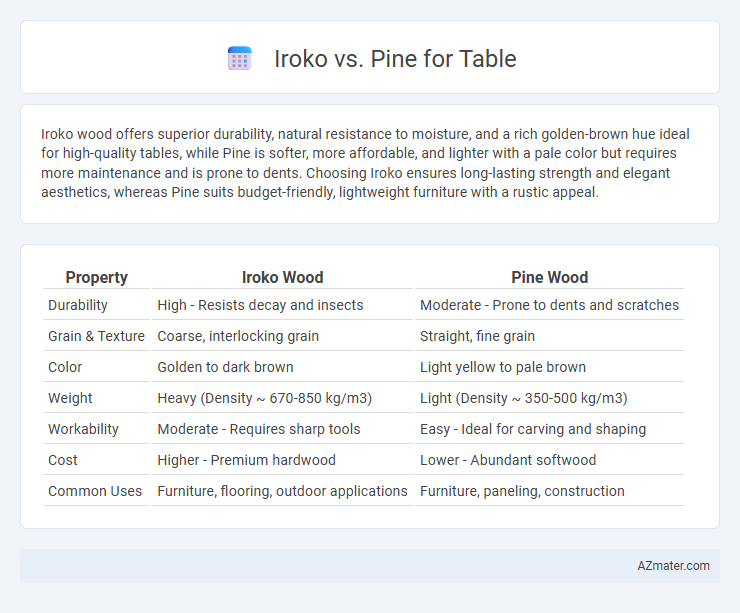Iroko wood offers superior durability, natural resistance to moisture, and a rich golden-brown hue ideal for high-quality tables, while Pine is softer, more affordable, and lighter with a pale color but requires more maintenance and is prone to dents. Choosing Iroko ensures long-lasting strength and elegant aesthetics, whereas Pine suits budget-friendly, lightweight furniture with a rustic appeal.
Table of Comparison
| Property | Iroko Wood | Pine Wood |
|---|---|---|
| Durability | High - Resists decay and insects | Moderate - Prone to dents and scratches |
| Grain & Texture | Coarse, interlocking grain | Straight, fine grain |
| Color | Golden to dark brown | Light yellow to pale brown |
| Weight | Heavy (Density ~ 670-850 kg/m3) | Light (Density ~ 350-500 kg/m3) |
| Workability | Moderate - Requires sharp tools | Easy - Ideal for carving and shaping |
| Cost | Higher - Premium hardwood | Lower - Abundant softwood |
| Common Uses | Furniture, flooring, outdoor applications | Furniture, paneling, construction |
Introduction to Iroko and Pine Woods
Iroko wood, known for its rich golden to dark brown hues, boasts exceptional durability and natural resistance to decay, making it a preferred choice for high-quality furniture. Pine wood, characterized by its pale yellow color and soft texture, offers affordability and ease of workability but requires protective finishes to enhance its limited resistance to moisture and wear. Both Iroko and Pine woods serve distinct purposes in furniture making, with Iroko favored for long-lasting, elegant tables and Pine offering a budget-friendly, lightweight alternative.
Physical Characteristics: Iroko vs Pine
Iroko wood is dense and heavy, with a Janka hardness rating of approximately 1,260 lbf, making it highly durable and resistant to wear, while pine is much softer at around 380 lbf, which results in easier denting and scratching. Iroko's coarse, interlocked grain pattern and natural golden to dark brown hues provide a rich, textured appearance, whereas pine features a lighter color palette with straight grain and frequent knots that give a rustic look. Moisture resistance in iroko is superior due to its natural oils, reducing warping and decay, in contrast to pine, which is more prone to moisture absorption and requires treatment for outdoor or high-humidity use.
Durability and Longevity Comparison
Iroko wood offers superior durability compared to pine, with natural resistance to rot, decay, and insect attacks, making it ideal for long-lasting tables. Pine, being a softer wood, is more prone to dents, scratches, and wear over time, reducing its longevity in high-use furniture. The dense grain structure of iroko significantly extends the lifespan of tables, maintaining structural integrity and appearance far beyond typical pine furniture.
Aesthetic Appeal and Grain Patterns
Iroko wood displays rich golden to medium brown hues with interlocking grain patterns that create a distinctive, attractive texture ideal for high-end tables. Pine offers a lighter, creamy color with a more uniform, straight grain and occasional knots, lending a rustic, warm charm perfect for casual or country-style furniture. The choice hinges on whether a bold, exotic appearance from Iroko or a simpler, more traditional look from Pine suits the desired table aesthetics.
Workability and Ease of Crafting
Iroko offers moderate workability with good machining characteristics, though its interlocked grain can cause occasional tear-out, requiring sharp tools and patience. Pine is easier to craft due to its softer texture and straight grain, allowing smooth cutting, shaping, and sanding with minimal effort. For projects requiring intricate detailing or faster workmanship, pine is preferable, while iroko provides greater durability but demands more skilled handling.
Cost and Availability Analysis
Iroko wood, known for its durability and rich color, is generally more expensive than pine due to its hardwood classification and slower growth rate, leading to limited availability in some regions. Pine, a softwood, is widely available and more affordable, making it a popular choice for budget-conscious furniture buyers. Cost efficiency and widespread accessibility make pine suitable for mass-produced tables, whereas iroko offers higher long-term value in terms of resistance to wear and aesthetic appeal.
Environmental Impact and Sustainability
Iroko wood, sourced primarily from West Africa, offers a durable and naturally resistant option with moderate environmental impact due to responsible harvesting initiatives and controlled logging practices. Pine, often sourced from fast-growing plantations in temperate regions, supports sustainability through rapid regrowth and carbon sequestration but may involve chemical treatments that affect biodegradability. Choosing iroko emphasizes longevity and reduced frequency of replacement, while pine's renewable nature and lower carbon footprint during cultivation highlight its eco-friendly advantages for table production.
Maintenance and Care Requirements
Iroko wood offers superior resistance to moisture and insects, requiring less frequent sealing and refinishing compared to pine, which is softer and more prone to dents and scratches, necessitating regular sealing or painting. Pine demands careful maintenance with periodic sanding and protective coatings to prevent warping and damage from humidity. Iroko's dense grain structure ensures durability and a low-maintenance surface ideal for long-lasting tables in both indoor and outdoor settings.
Best Use Cases for Dining Tables
Iroko wood offers superior durability and natural resistance to moisture and insects, making it ideal for dining tables that see frequent use and require long-lasting strength. Pine, with its softer texture and lighter weight, is best suited for dining tables in low-traffic settings or for casual, rustic styles where affordability and ease of customization are priorities. For robust, everyday dining furniture that balances aesthetics with resilience, Iroko is the preferred choice, while Pine works well for budget-friendly or decorative tables.
Final Verdict: Choosing Between Iroko and Pine
Iroko offers superior durability, resistance to decay, and a rich, hardwood aesthetic, making it ideal for long-lasting, high-end tables that withstand heavy use. Pine is a softer, more affordable wood with a lighter color and easier workability, suited for budget-friendly, rustic-style tables that can be easily refinished. The final choice hinges on balancing longevity and premium appearance with cost and ease of customization.

Infographic: Iroko vs Pine for Table
 azmater.com
azmater.com